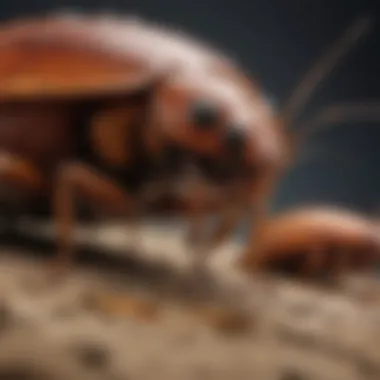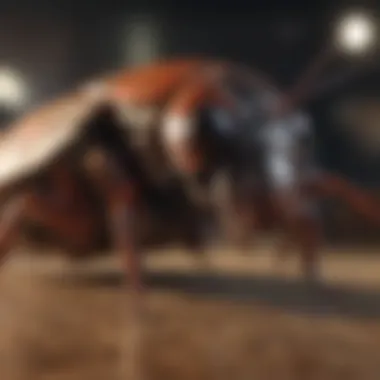Do Cockroaches Carry Diseases? Exploring Health Risks


Intro
Animal Profile
General Overview
Cockroaches belong to the order Blattodea, with over 4,500 species identified globally. The most common types found in urban environments include the American cockroach, German cockroach, and Oriental cockroach. Physically, these insects feature a flat, oval body, long antennae, and a robust exoskeleton. Their resilience is remarkable; they can survive extreme conditions and thrive in various habitats.
Habitat and Distribution
Cockroaches prefer warm, dark environments, typically hiding in areas close to food and moisture sources. They are often found in kitchens, basements, and sewers. The distribution of cockroaches is widespread, making them a persistent problem in urban settings. Their ability to reproduce rapidly contributes to their continual presence in human habitats, making effective control measures essential for public health.
Disease Transmission
While many individuals associate cockroaches with disease, it is crucial to explore the scientific evidence surrounding this claim. Cockroaches can carry pathogens such as bacteria, viruses, and parasites. Some notable diseases linked to cockroaches include:
- Salmonellosis
- Gastroenteritis
- Allergies and asthma triggered by cockroach droppings and body parts.
The mechanics of disease transmission involve cockroaches contaminating food and surfaces as they scavenge. Their excrement and shed skins can also provoke allergic reactions and worsen respiratory conditions.
"Cockroaches are capable of carrying more than 30 types of bacteria, including E. coli and Salmonella, posing serious health risks to humans."
Prevention and Control Strategies
To mitigate the health risks associated with cockroaches, several prevention strategies are advisable:
- Maintain cleanliness: Regularly clean kitchens and dining areas to eliminate food debris.
- Seal entry points: Close gaps and cracks in walls, windows, and doors to prevent entry.
- Use traps and baits: Employ cockroach traps and baits as part of a pest management plan.
- Consult professionals: In case of severe infestations, consider hiring pest control experts.
By adopting these measures, individuals can significantly reduce the likelihood of cockroach infestations and their potential health hazards.
Epilogues
In summary, cockroaches are more than mere nuisances; they can act as vectors for various diseases that pose health risks to humans. Their resilience and reproductive capabilities pose challenges for control. Understanding their behavior, habitat preferences, and potential risks helps inform the public about preventive practices. The key to managing cockroach populations lies in proactive measures aimed at maintaining a clean environment and disrupting their breeding grounds.
Prolusion to Cockroaches and Health Risks
Cockroaches are not just common household nuisances; they also pose significant health risks. Understanding the relationship between these insects and disease transmission is crucial for public health. This section identifies key elements about cockroaches that impact human health and highlights why this topic is essential for anyone interested in sanitary living environments.
In both residential and commercial spaces, cockroaches present several potential hazards. They are adept at traversing surfaces that humans rely on for food, cleanliness, and overall well-being. By coming into contact with food items or surfaces, cockroaches can facilitate the transfer of pathogens. Thus, understanding the biological and behavioral traits of these insects can better inform prevention strategies.
Moreover, awareness of the specific health risks associated with cockroaches can lead to more effective pest control measures. Knowledge is indeed power; by equipping ourselves with info on how these pests operate, we can address the root causes of infestations. An informed approach also enables the identification of the best practices to maintain a cockroach-free environment.
Understanding Cockroach Biology
Cockroaches belong to the order Blattodea and are known for their resilience and adaptability. They can survive in various environmental conditions and have been on Earth for millions of years. Understanding their biology is critical for grasping how they can thrive in human habitats.
Cockroaches possess several remarkable features. Their flat bodies allow them to hide in narrow crevices, while their rapid movement helps them escape predators. Additionally, they have a well-developed sense of smell, which they use to find food and mates. This understanding is pivotal, as it highlights the challenges faced when attempting to control cockroach populations.
In addition, cockroaches are omnivorous scavengers, which means they will consume a variety of organic materials, including human food waste. Their diets are not exclusive to food scraps; they are also known to feed on paper, glue, and even hair or nails. This diverse feeding behavior enables them to thrive in various environments, making management efforts more challenging.
Common Species of Cockroaches


Several species of cockroaches are commonly found in urban areas, and each varies slightly in behavior and habitat. The American cockroach is one of the largest species and typically resides in warmer areas, such as basements and sewers. In contrast, the German cockroach, smaller in size, often thrives in kitchens and pantries, making it a common sight in many homes.
Another notable species is the Oriental cockroach, which prefers moist, cool environments, such as those found near plumbing. Additionally, the brown-banded cockroach, known for its adaptability, can survive in somewhat drier areas compared to other species.
Understanding these different species is important for both identification and treatment. Specific control methods may be more effective for certain species. Therefore, knowing which type of cockroach is present can significantly enhance the effectiveness of pest management strategies.
Pathogens Associated with Cockroaches
The presence of cockroaches in living spaces is not just a nuisance; it poses a significant health risk due to the pathogens they can carry. Understanding the pathogens associated with cockroaches is crucial for anyone seeking to mitigate health concerns related to these pests. This section delves into the specific types of pathogens cockroaches may harbor, providing insights into their implications for human health.
Bacteria Carried by Cockroaches
Cockroaches are known to carry various bacteria that can have serious health implications. Some of the most common bacteria associated with cockroaches include Salmonella, E. coli, and Staphylococcus aureus. These bacteria can spread through direct contact or indirectly by contaminating food surfaces.
Here are a few points to consider about bacteria carried by cockroaches:
- Salmonella: This bacterium can lead to food poisoning, with symptoms including diarrhea, fever, and abdominal cramps. In severe cases, it may necessitate hospitalization.
- E. coli: Strains of E. coli can result in severe gastrointestinal illness. Some strains produce toxins, leading to potentially life-threatening conditions.
- Staphylococcus aureus: This bacterium can cause skin infections, respiratory issues, and food poisoning.
The Centers for Disease Control and Prevention (CDC) indicates that the presence of cockroaches in kitchen and dining areas can lead to food contamination, thus increasing the risk of illness.
Viruses Linked to Cockroaches
While less frequently discussed compared to bacteria, viruses can also be associated with cockroach infestations. Research indicates that cockroaches may transmit viruses through their feces and saliva.
The key takeaways regarding viruses linked to cockroaches include:
- Astroviruses: These viruses can cause gastroenteritis, leading to diarrhea and vomitting, particularly in young children.
- Norovirus: Often known as the “winter vomiting bug,” norovirus can cause severe gastrointestinal issues and is highly contagious.
- Coxsackievirus: This can result in several conditions including hand, foot, and mouth disease.
Studies show that the ability of cockroaches to thrive in unsanitary conditions increases their potential to harbor and spread these viruses, especially in urban areas.
Parasites Transmitted by Cockroaches
In addition to bacteria and viruses, cockroaches can act as vectors for parasites. They may carry various parasitic organisms that can affect humans and animals alike. Understanding these parasites is essential for assessing the full extent of the health risks associated with cockroach infestations.
Important parasitic threats include:
- Helminths: These are worms such as Ascaris lumbricoides, which can thrive in the human gastrointestinal tract and potentially cause malnutrition.
- Protozoa: Like the species of Entamoeba histolytica, this can lead to amoebic dysentery, characterized by severe diarrhea.
- Fungi: Certain fungi can be transmitted through cockroach droppings and may cause allergic reactions.
The possibility of parasitic transmission underscores the need for effective pest management strategies.
How Cockroaches Spread Diseases
Understanding how cockroaches spread diseases is crucial in addressing the public health risks they pose. This section explores the habits and habitats of cockroaches, as well as the specific mechanisms by which these pests contaminate their environments. Recognizing these factors can empower individuals and communities to implement effective prevention strategies.
Cockroach Habits and Habitats
Cockroaches thrive in a wide array of environments. They prefer warm, moist locations that offer abundant food sources. Common habitats include kitchens, bathrooms, and basements, where they have easy access to human food and waste. Cockroaches are nocturnal, often becoming active at night when humans are less likely to notice them.
These pests are drawn to cluttered areas where they can hide easily. Dark spaces like cracks, crevices, and behind appliances serve as ideal nests. Moreover, since cockroaches can reproduce rapidly, a small infestation can quickly escalate into a larger problem. It is essential to understand their behavior to effectively prevent and control their presence in homes and commercial spaces.
Mechanisms of Contamination
Cockroaches carry various pathogens on their bodies, primarily on their legs and bodies. When they move about, they can easily transfer bacteria, viruses, and allergens to surfaces and food. This unintentional contamination can result in significant health hazards, particularly for vulnerable populations.


The mechanisms through which cockroaches contaminate environments include:
- Physical contact: Cockroaches crawl over surfaces, leaving behind saliva, feces, and body fragments that can harbor pathogens.
- Excretion: Their droppings often contain harmful bacteria, which can spread diseases upon contact with food or surfaces.
- Airborne allergens: When cockroach body parts and droppings break down, they can become airborne allergens, posing risks to individuals with asthma or allergies.
By understanding these mechanisms, it becomes clear why effective cockroach management is imperative not just for comfort, but also for public health.
Effective cockroach management significantly reduces the risk of disease transmission, thus safeguarding individual and community health.
This knowledge empowers homeowners and businesses to take proactive steps in ensuring their spaces remain healthy and free from disease risks.
Health Implications of Cockroach Infestations
The issue of cockroach infestations goes beyond mere discomfort. These insects are known carriers of various pathogens, which can result in significant health risks for humans. Understanding the health implications related to cockroaches helps individuals recognize the importance of immediate action against infestations. Awareness of the pathogens they transmit and the diseases they may cause is essential for public health.
Cockroaches thrive in unsanitary conditions. They often inhabit locations such as kitchens and bathrooms, where they may come into contact with food or surfaces used by humans. Recognizing the potential for transmission of diseases transforms how we view pest control. It is vital to initiate preventive measures rather than wait for infestations to arise.
Common Diseases Linked to Cockroaches
Cockroaches are implicated in the transmission of several diseases, which mainly arise as a result of their feeding and nesting habits. Here are some notable diseases:
- Salmonellosis: Cockroaches can carry bacteria such as Salmonella, leading to food poisoning. Symptoms include diarrhea, fever, and abdominal cramps.
- Gastroenteritis: Ingesting food contaminated by cockroach feces can lead to gastroenteritis, which results in inflammation of the stomach and intestines. Symptoms often include vomiting and diarrhea.
- Dysentery: Some species of cockroaches can contribute to the spread of pathogens that cause dysentery, marked by severe diarrhea with blood.
The implications of these diseases extend beyond just discomfort. In some cases, they can lead to severe health complications, particularly for vulnerable populations, including the elderly and immunocompromised individuals.
Impact on Asthma and Allergies
Cockroach infestations significantly impact respiratory health. Their droppings, saliva, and body parts can trigger alarms in sensitive individuals. These allergens can lead to various allergic reactions, including:
- Asthma attacks: Exposure to cockroach allergens is a known trigger for asthma. This is particularly concerning for children who may already have respiratory issues.
- Allergic rhinitis: Symptoms such as sneezing and nasal congestion may arise in response to cockroach allergens, affecting overall quality of life.
Data shows that many urban areas with high cockroach prevalence also report higher incidences of asthma among residents. The connection underscores the critical need for effective pest management strategies.
The link between cockroach presence and health issues emphasizes the necessity for preventive steps to maintain a healthy living environment.
Prevention and Control Measures
Effective prevention and control measures are crucial in managing the risks associated with cockroaches and the diseases they may carry. Understanding these measures can significantly reduce the likelihood of infestation and the health implications it brings. This section explores proper sanitation practices, effective pest control strategies, and environmental management techniques, all aimed at minimizing the presence of these pests in our living and working environments.
Proper Sanitation Practices
Sanitation is the first line of defense against cockroach infestations. Maintaining a clean environment not only deters cockroaches but also minimizes potential health risks related to pathogens they carry. Key strategies include:
- Regular Cleaning: Sweep and mop floors daily to eliminate food particles and spills. Paying close attention to corners and under appliances is important, as cockroaches often hide there.
- Food Storage: Store food in airtight containers. Do not leave pet food out overnight, as this can attract cockroaches.
- Waste Management: Dispose of garbage regularly and use bins with tight-fitting lids. Overflowing or uncovered trash can be an inviting habitat for cockroaches.
Implementing these basic sanitation practices can significantly reduce attractants and entry points for these pests.
Pest Control Strategies
When sanitation alone cannot prevent an infestation, pest control strategies become necessary. Various methods can be utilized to effectively manage and eliminate cockroach populations:
- Boric Acid: This insecticide can be applied in places where cockroaches frequent. It is effective for controlling populations but should be applied with caution to avoid accidental exposure to pets and children.
- Gel Baits: These contain attractants and insecticides that cockroaches consume. They allow for targeted treatment and can be placed in hard-to-reach areas.
- Professional Extermination: For severe infestations, hiring a pest control professional may be required. They can provide expert assessments and deploy methods that are safe and effective.


Choosing the right pest control strategies is essential for not only eliminating existing cockroaches but also preventing future infestations.
Environmental Management Techniques
In addition to sanitation and pest control, environmental management techniques are vital in creating an inhospitable environment for cockroaches:
- Seal Entry Points: Inspect your home for cracks and holes, especially around windows, doors, and plumbing. Sealing these gaps can prevent cockroaches from entering.
- Moisture Control: Cockroaches are attracted to moisture. Fix leaks and use dehumidifiers in damp areas like basements and bathrooms. This makes the environment less conducive to their survival.
- Landscape Management: Keep outdoor areas tidy and free from debris where cockroaches might thrive. Trim shrubs and keep mulch away from foundation walls to reduce sheltering opportunities.
Implementing these environmental management techniques can considerably decrease the likelihood of cockroach presence.
In a multi-faceted approach that combines proper sanitation, effective pest control methods, and environmental management, it becomes possible to significantly mitigate the risks posed by cockroaches and the diseases they carry.
Addressing Misconceptions About Cockroaches
Cockroaches are often vilified and regarded as filthy pests. Understanding the truth behind these sentiments is essential. This section aims to clarify common misunderstandings about cockroaches and highlight their role in nature.
Common Myths Debunked
There are several myths surrounding cockroaches that warrant examination. One prevalent belief is that all cockroaches are disease carriers. While it is true that they can transmit certain pathogens, not all species pose a threat to human health. For instance, the German cockroach is more closely associated with disease transmission compared to the American cockroach, which is less likely to come into direct contact with food sources.
Another myth is that cockroaches thrive in unclean environments. In fact, they can inhabit both clean and dirty environments. Urban areas, where food is readily available and shelter is abundant, often provide ideal conditions for many cockroach species.
Moreover, some people believe that cockroaches are entirely nocturnal and not active during the day. Although they prefer the cover of darkness, many cockroaches may be observed during daylight if they are disturbed or if their population is high. Understanding these nuances can aid in developing a more balanced view of these creatures.
The Key Points:
- Not all cockroach species are equal in their disease transmission potential.
- Clean environments can still harbor cockroaches due to food access.
- Cockroaches can be active during the day.
The Ecological Role of Cockroaches
While many view cockroaches as merely pests, they serve important ecological functions. They help break down organic matter, contributing to nutrient cycling in their environments. By feeding on decaying materials, cockroaches play a role in soil health and support various ecosystems.
Additionally, their presence in the food chain is significant. Many animals, including birds and reptiles, rely on cockroaches as a food source. Their existence maintains ecological balance, which is crucial for biodiversity.
In urban settings, cockroaches often thrive in sewers and waste sites. They contribute to the decomposition of waste material, indirectly supporting waste management systems. This role, while unglamorous, underscores their importance in both natural and human-altered ecosystems.
Understanding the ecological role of cockroaches reminds us that every creature has a place in the environment, even those we consider pests.
In summary, addressing misconceptions about cockroaches allows for a more rounded understanding of their impact. By debunking myths and appreciating their ecological role, we can foster a more informed discussion surrounding these organisms.
End
The topic of cockroaches and their potential health risks is crucial for understanding the implications of having these pests in our homes and environments. Through the exploration of this article, we have highlighted the various diseases that can be linked to cockroaches, providing insight into how these pests can compromise public health. It is essential to recognize the significance of sanitation, habitat management, and pest control.
Summary of Health Risks and Control
In summary, cockroaches are not just an unsightly nuisance; they are vectors for numerous pathogens that can lead to serious health issues. Common health risks include gastroenteritis, asthma exacerbation, and allergic reactions due to the allergens produced by cockroach droppings, skin, and saliva. The relationship between cockroaches and human health necessitates an understanding of their habits and the environments they thrive in.
To mitigate these risks, effective control measures should be implemented. This includes:
- Regular cleaning and proper food storage to deter cockroach attraction.
- Use of pest control strategies such as traps and insecticides.
- Regular inspections of homes and buildings to identify and address infestations early.
Effective management combines sanitation, awareness, and timely action to ensure a healthier living environment.
Final Thoughts on Cockroach Management
Engagement in community health efforts can further enhance cockroach management. Working with pest control specialists and educating others about the signs of infestation can foster a collective effort to address issues effectively.
Overall, the knowledge gained from this article is pivotal not only for individuals but also for communities striving for better public health standards. By prioritizing awareness and control, we can minimize the health risks associated with cockroaches and create safer spaces.















